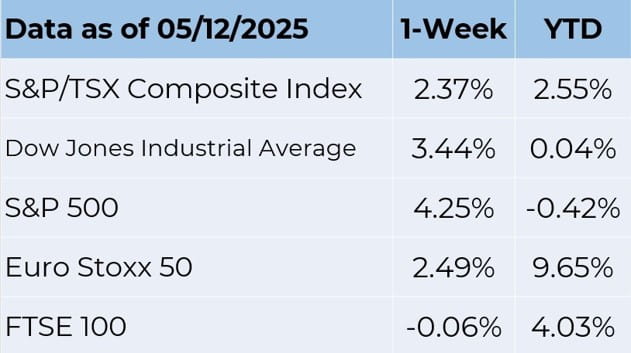Weekly Market Commentary May 28 2025
Young Canadian’s Uncertainty
The Canadian labour market is the bleakest it’s been in decades. It’s a harsh reality that Canadians have to contend with, as the economy reels from the impact of a long-running trade standoff with the U.S. The unemployment rate surging to highs of 6.9 per cent on the economy, only adding 7,400 jobs in April, is a clear indicator that things are not going well, something that threatens to jeopardize the financial futures of young Canadians.
While the economy was highly expected to recover, the Canadian central bank cutting interest rates has not been the case. Economic challenges have gotten out of hand in the U.S. trade war, exacerbating the situation. Newly-elected Prime Minister Mark Carney faces an uphill task in reversing the significant economic downturn, as Canada’s labour market shows signs of deterioration.
Until now, the economic harm caused by Trump's tariff strategy has been chiefly theoretical because different indicators, including inflation, have held up. Nevertheless, financial data is also beginning to reflect the impact of the tariff policy. With sales declining in 13 of the 21 subsectors, manufacturing sales in Canada, which is seen as a key sign of economic health, declined 1.4 per cent in March for the second straight month.
It’s becoming increasingly difficult for young people trying to enter the workforce amid deteriorating macroeconomics. The unemployment rate for postgraduates has already risen to record highs of 11.2 per cent, marking the highest rate in at least two decades. The high unemployment rate paints a bleak future for young people trying to launch careers, gain financial independence, and secure long-term financial futures.
Economists have already warned that graduating during such a pronounced economic downturn could have enduring negative consequences for young people trying to launch their careers. The financial ramifications for heightened unemployment for young people could be substantial and long-lasting. For starters, it could hamper their ability to initiate savings and invest early in their careers, a cornerstone of long-term financial security.
Amid the economic growth uncertainty, the Canadian stock market remains in a recovery mode, surging to fresh all-time highs last week. The country’s main stock index, the Toronto Stock Exchange, climbed 0.7 per cent on Friday to highs of 25,886. The gains in the equity market have come despite sharp losses on crude prices, given that the stock market is heavily weighted in energy companies.
The iShares MSCI Canada exchange-traded fund (EWC) is up by nearly 20 per cent since April, following a decline of over 11 per cent during the first week of that month. This performance closely mirrors the gains observed in the U.S. market within the same timeframe.
The iShares MSCI Canada exchange-traded fund (EWC) acts as a liquid investment option for U.S. investors seeking exposure to Canadian equities. It monitors the S&P/TSX index. Since April, price movements have created a V-shaped recovery, with current prices reaching new all-time highs.
The Markets
Last week, the U.S. stock market showed why it’s a good idea to stay invested through bouts of volatility.
Major U.S. stock indices notched sizeable gains, as investors celebrated a trade truce with China and better-than-expected inflation numbers, while brushing off a tepid consumer sentiment reading. Here’s what happened:
The administration negotiated a trade truce with China. The United States and China agreed to reduce tariffs for 90 days. U.S. tariffs on Chinese imports will fall to 30 per cent, while China’s tariffs on U.S. imports will drop to 10 per cent. The Wall Street Journal reported, “The agreement lowered tariff levels far more than Wall Street had expected, with one analyst…calling the deal a ‘best-case scenario’ for investors. Goldman Sachs cut its U.S. recession odds to 35 [per cent] from 45 [per cent] and boosted its growth forecast.”
Inflation is closing in on the Federal Reserve’s target. Prices increased by 2.3 per cent year over year in April. That put headline inflation just a smidge above the Fed’s two per cent target. When the volatile categories of food and energy were excluded, prices were up 2.8 per cent year over year. The price of eggs fell by 13 per cent month to month, leading a decline in the cost of food. Five of six major grocery store food group indexes moved lower in April.
Consumers were concerned about inflation. While the Consumer Price Index’s April inflation numbers were encouraging, the inflation numbers in the University of Michigan’s Consumer Sentiment Survey were less so. “Year-ahead inflation expectations surged from 6.5 [per cent] last month to 7.3 [per cent] this month…Long-run inflation expectations lifted from 4.4 [per cent] in April to 4.6 [per cent] in May...,” reported Surveys of Consumers Director Joanne Hsu.
The U.S. bond market was in a less cheerful mood than the U.S. stock market last week. On Friday, Moody’s lowered the rating for U.S. government bonds on concerns about the deficit (the difference between how much the government spends each year and how much it takes in through taxes) and rising interest costs. The rating service explained:
“Successive U.S. administrations and Congress have failed to agree on measures to reverse the trend of large annual fiscal deficits and growing interest costs. We do not believe that material multi-year reductions in mandatory spending and deficits will result from current fiscal proposals under consideration.”
Over the week, U.S. stock markets saw solid gains with the Standard & Poor’s 500 Index moving into positive territory for the year to date. U.S. Treasury yields ended the week near where they started.

Source: FactSet
Weekly Focus – Think About It
"Heroism doesn’t always happen in a burst of glory. Sometimes small triumphs and large hearts change the course of history. Sometimes a chicken can save a man’s life."
– Mary Roach, Author
Best regards,
Eric Muir
B.Comm (Hons. Finance), CIM®, FCSI
Senior Portfolio Manager
Derek Lacroix
BBA, CIM®, CFP®
Associate Portfolio Manager

P.S. Please feel free to forward this commentary to family, friends or colleagues. If you would like us to add them to the list, please reply to this email with their email address and we will ask for their permission to be added.
Disclaimer:
Information in this article is from sources believed to be reliable, however, we cannot represent that it is accurate or complete. It is provided as a general source of information and should not be considered personal investment advice or solicitation to buy or sell securities. The views are those of the author, Eric Muir and Derek Lacroix and not necessarily those of Raymond James Ltd. Investors considering any investment should consult with their Investment Advisor to ensure that it is suitable for the investor’s circumstances and risk tolerance before making any investment decision. Raymond James Ltd. is a Member Canadian Investor Protection Fund.

